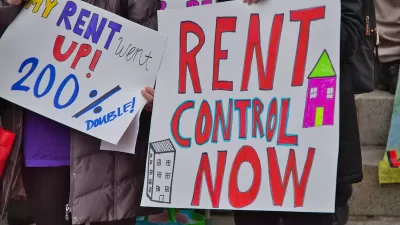With rental vacancy rates declining across America, the expansion of rent control policies may seem like a logical solution for protecting vulnerable renters from fast rising prices. But Peter Tatian argues there's little evidence that it works.
As cities across the U.S. search for solutions for the growing crisis in affordable housing, Tatian samples the research literature on the application of rent control and finds "very little evidence that rent control is a good policy."
"Arguments against rent control go back as far as the 1970s and the RAND housing allowance experiments in New York City. More recently, a MIT study of the 1995 repeal of rent control in Cambridge, Massachusetts, found that investment in housing increased after rent control ended, leading to “major gains in housing quality.” A National Bureau of Economic Research paper also examined the Cambridge experience and concluded that 'elimination of rent control added about $1.8 billion to the value of Cambridge’s housing stock between 1994 and 2004, equal to nearly a quarter of total Cambridge residential price appreciation in this period.'”
But what about more nuanced "rent stabilization" policies? In a comprehensive overview of the research literature, Blair Jenkins found that "rent stabilization doesn’t do a good job of protecting its intended beneficiaries—poor or vulnerable renters—because the targeting of the benefits is very haphazard," notes Tatian.
"Given the current research, there seems to be little one can say in favor of rent control," concludes Tatian. "What, then, should be done to help renters obtain affordable, decent housing? A better approach may be adopting policies that encourage the production of more diverse types of housing (different densities, tenure types, unit sizes, etc.), implementing strong regulations and practices to ensure housing quality and to protect tenants from abuses; and providing targeted, direct subsidies to people who need help paying their rents."
FULL STORY: Is Rent Control Good Policy?

Planetizen Federal Action Tracker
A weekly monitor of how Trump’s orders and actions are impacting planners and planning in America.

Map: Where Senate Republicans Want to Sell Your Public Lands
For public land advocates, the Senate Republicans’ proposal to sell millions of acres of public land in the West is “the biggest fight of their careers.”

Restaurant Patios Were a Pandemic Win — Why Were They so Hard to Keep?
Social distancing requirements and changes in travel patterns prompted cities to pilot new uses for street and sidewalk space. Then it got complicated.

Platform Pilsner: Vancouver Transit Agency Releases... a Beer?
TransLink will receive a portion of every sale of the four-pack.

Toronto Weighs Cheaper Transit, Parking Hikes for Major Events
Special event rates would take effect during large festivals, sports games and concerts to ‘discourage driving, manage congestion and free up space for transit.”

Berlin to Consider Car-Free Zone Larger Than Manhattan
The area bound by the 22-mile Ringbahn would still allow 12 uses of a private automobile per year per person, and several other exemptions.
Urban Design for Planners 1: Software Tools
This six-course series explores essential urban design concepts using open source software and equips planners with the tools they need to participate fully in the urban design process.
Planning for Universal Design
Learn the tools for implementing Universal Design in planning regulations.
Heyer Gruel & Associates PA
JM Goldson LLC
Custer County Colorado
City of Camden Redevelopment Agency
City of Astoria
Transportation Research & Education Center (TREC) at Portland State University
Camden Redevelopment Agency
City of Claremont
Municipality of Princeton (NJ)





























